If you’ve been scrolling through #FitTok lately, you’ve probably seen people raving about “Japanese Walking”.
It’s not exactly new; this clever twist on interval walking has been around for years, but the trend has found fresh legs on TikTok.
It promises a simple, free way to lose weight, boost heart health, and spice up your daily walk, no fancy gym needed.
At its core, Japanese walking is just interval walking alternating between three minutes of brisk, heart-pumping strides and three minutes of slower recovery walking.
Repeat this for 30 minutes, about four times a week, and you’ve got yourself a routine that researchers say can transform your body and mind. Why is everyone suddenly obsessed? One reason is how doable it is.
“Exercise matters and intensity matters,” explains Laura Richardson, exercise physiologist and clinical associate professor of kinesiology at the University of Michigan, according to “Time”.
“It’s sustainable. It’s short. You don’t need a gym or fancy equipment. And there’s a long list of health benefits.”
That’s not just hype. One landmark study by Dr Shizue Masuki and colleagues at Shinshu University Graduate School of Medicine in Japan put interval walking to the test.
They asked over 200 adults to power-walk at high intensity for 30 minutes daily. Most quit, too tough, too boring. So the researchers tweaked it: three minutes hard, three minutes easy. People stuck with it and saw real gains.
Over five months, participants who interval-walked improved leg strength, boosted thigh muscle, lowered blood pressure, and even improved sleep and mood.
Masuki’s research, published in “The Journal of Applied Physiology”, shows interval walking also helps manage lifestyle diseases like high blood pressure and obesity, while lifting “good” HDL cholesterol and trimming belly fat.
How does interval walking work?
It’s all about tricking your body into working harder in less time. You’re getting your heart rate up and then letting it recover, says gait and walking expert Rashelle Hoffman, from Creighton University’s physical therapy department.
When you push into that higher heart rate zone, even briefly, your body starts to adapt: stronger lungs, better circulation and improved endurance.
@coacheugeneteo Walking 10,000 steps… But better 😯 I know I can’t be the only one who looks at my step count at the end of the day and feel like a failure. Some days, I get around 2,000 steps. I still aim for at least 8,000 a day – but sometimes, life just gets in the way. But even if it’s only an extra ~3000 steps, this simple 30 minute protocol on my walking pad can make a huge difference.
♬ original sound – Eugene Teo
The blueprint of sports medicine recommends adults get 150 minutes of moderate-intensity exercise a week, or 75 minutes of vigorous exercise.
Interval walking ticks both boxes, meaning you can get big results in shorter sessions. But what’s ‘high intensity,’ really?
In Masuki’s study, walkers pushed to about 70% of their peak aerobic capacity, enough to feel their heart pounding, but still able to talk. Richardson suggests a simple “talk test”:
If you’re breathing heavily and can speak only in short sentences, you’re probably in the sweet spot.
Getting started: No excuses needed
What’s interesting about Japanese walking is that it slips so easily into real life. You don’t need fancy leggings or a new smartwatch, just your legs, a safe space to walk and a timer.
Proponents of this ‘new trend’ recommend easing in if the idea of three full minutes at top speed feels scary. Start with one-minute surges and build up. Even busy parents can make it work.

Expert-backed hacks to make it stick:
- Use music: Many songs run about three minutes, perfect for timing intervals.
- Check your posture: Spine tall, shoulders relaxed, arms swinging for extra power.
- Go hands-free: Set your smartwatch or phone to beep you through your intervals.
- Try poles: Walking poles add balance if you’re older or just want extra stability.
- Switch it up: Hills, trails, the beach, changing your terrain keeps things interesting and challenges your muscles in new ways. And if you want to level up, try adding wrist weights or slipping in squats or lunges during a recovery period.
Why walking might just be your secret weapon
We are obsessed with fancy fitness fads. Japanese walking is refreshing: a workout for real life. No gym fees. No complicated moves. Just step outside your door and start.
Plus, walking itself has serious benefits: stronger bones, happier joints, and a big mental health boost. It’s gentle enough for beginners and powerful enough to help manage conditions like high blood pressure or high cholesterol.
Walking with a bit more purpose could be the secret to a healthier heart, stronger body and calmer mind.
